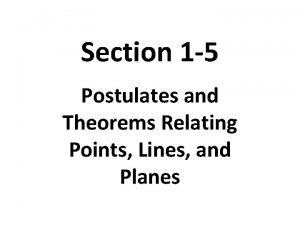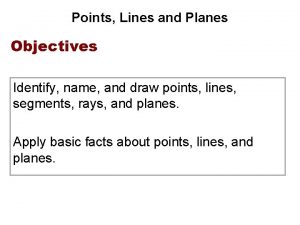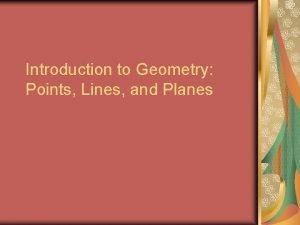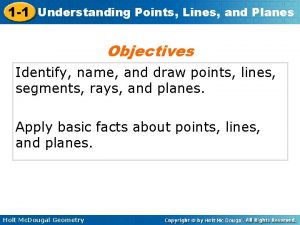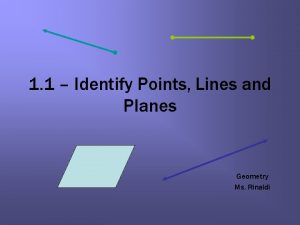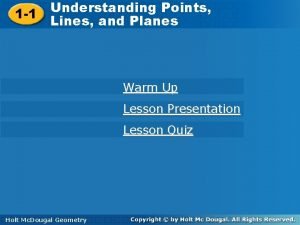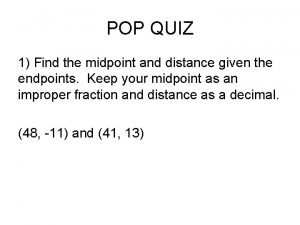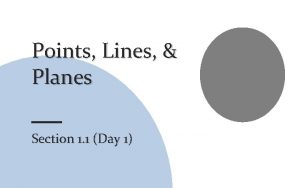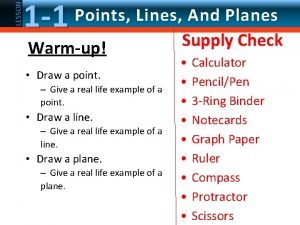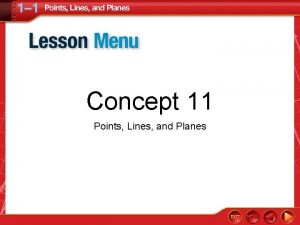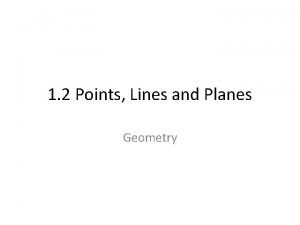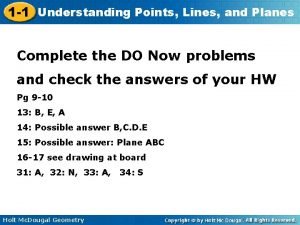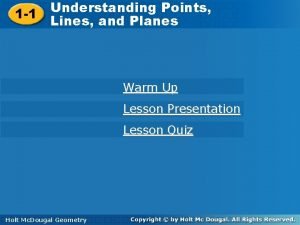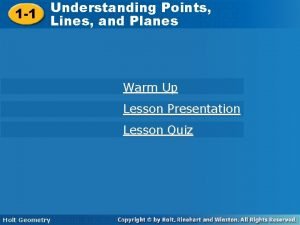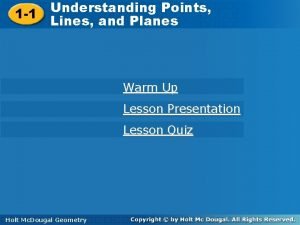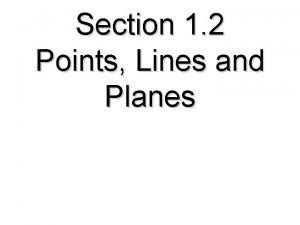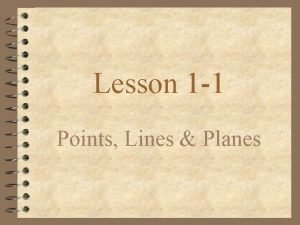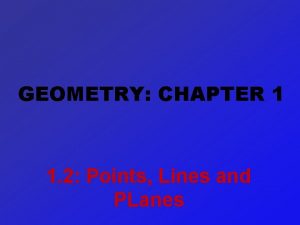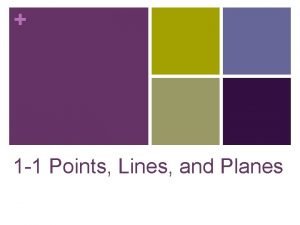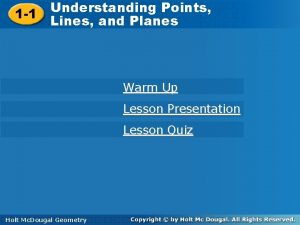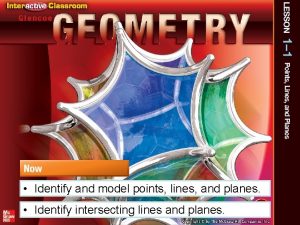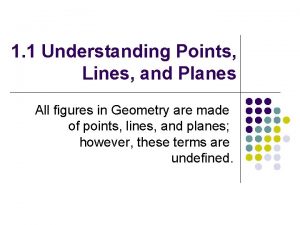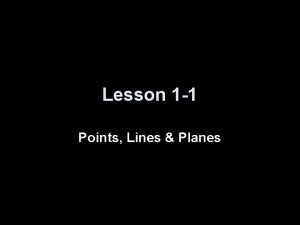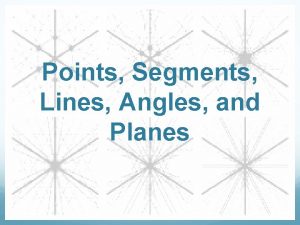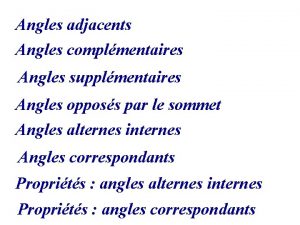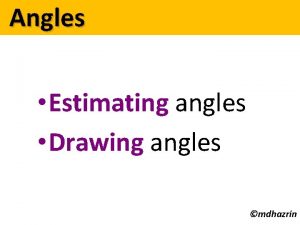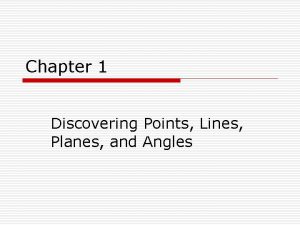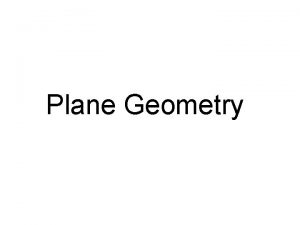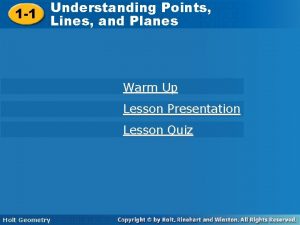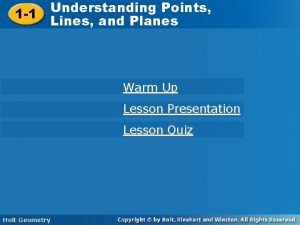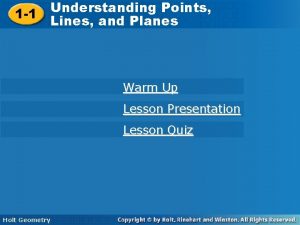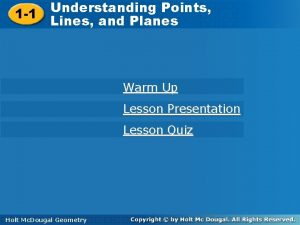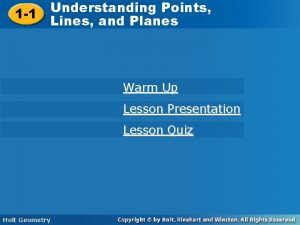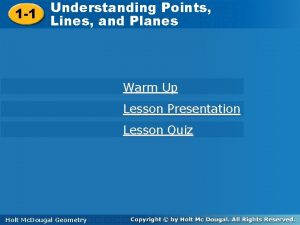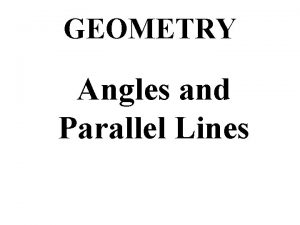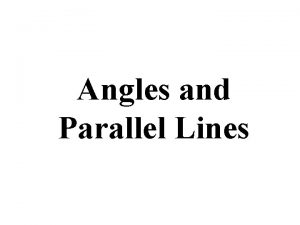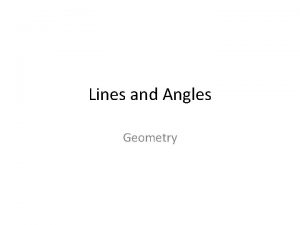Section 9 1 Points Lines Planes and Angles




























- Slides: 28

Section 9. 1 Points, Lines, Planes, and Angles Copyright 2013, 2010, 2007, Pearson, Education, Inc.

What You Will Learn Points Lines Planes Angles 9. 1 -2 Copyright 2013, 2010, 2007, Pearson, Education, Inc.

Basic Terms A point, line, and plane are three basic terms in geometry that are NOT given a formal definition, yet we recognize them when we see them. 9. 1 -3 Copyright 2013, 2010, 2007, Pearson, Education, Inc.

Lines, Rays, Line Segments A line is a set of points. Any two distinct points determine a unique line. Any point on a line separates the line into three parts: the point and two half lines. A ray is a half line including the endpoint. A line segment is part of a line between two points, including the endpoints. 9. 1 -4 Copyright 2013, 2010, 2007, Pearson, Education, Inc.

Basic Terms Description Diagram Line AB A Ray AB B B A Ray BA B A Line segment AB 9. 1 -5 Symbol A B Copyright 2013, 2010, 2007, Pearson, Education, Inc.

Plane We can think of a plane as a twodimensional surface that extends infinitely in both directions. Any three points that are not on the same line (noncollinear points) determine a unique plane. 9. 1 -6 Copyright 2013, 2010, 2007, Pearson, Education, Inc.

Plane Two lines in the same plane that do not intersect are called parallel lines. 9. 1 -7 Copyright 2013, 2010, 2007, Pearson, Education, Inc.

Plane A line in a plane divides the plane into three parts, the line and two half planes. 9. 1 -8 Copyright 2013, 2010, 2007, Pearson, Education, Inc.

Plane Any line and a point not on the line determine a unique plane. The intersection of two distinct, non-parallel planes is a line. 9. 1 -9 Copyright 2013, 2010, 2007, Pearson, Education, Inc.

Plane Two planes that do not intersect are said to be parallel planes. 9. 1 -10 Copyright 2013, 2010, 2007, Pearson, Education, Inc.

Angles An angle is the union of two rays with a common endpoint; denoted. 9. 1 -11 Copyright 2013, 2010, 2007, Pearson, Education, Inc.

Angles The vertex is the point common to both rays. The sides are the rays that make the angle. There are several ways to name an angle: 9. 1 -12 Copyright 2013, 2010, 2007, Pearson, Education, Inc.

Angles The measure of an angle is the amount of rotation from its initial to its terminal side. Angles can be measured in degrees, radians, or gradients. 9. 1 -13 Copyright 2013, 2010, 2007, Pearson, Education, Inc.

Angles are classified by their degree measurement. Right Angle is 90º Acute Angle is less than 90º Obtuse Angle is greater than 90º but less than 180º Straight Angle is 180º 9. 1 -14 Copyright 2013, 2010, 2007, Pearson, Education, Inc.

Angles 9. 1 -15 Copyright 2013, 2010, 2007, Pearson, Education, Inc.

Types of Angles Adjacent Angles - angles that have a common vertex and a common side but no common interior points. Complementary Angles - two angles whose sum of their measures is 90 degrees. Supplementary Angles - two angles whose sum of their measures is 180 degrees. 9. 1 -16 Copyright 2013, 2010, 2007, Pearson, Education, Inc.

Example 3: Determining Complementary Angles In the figure, we see that 9. 1 -17 Copyright 2013, 2010, 2007, Pearson, Education, Inc.

Example 3: Determining Complementary Angles Solution 9. 1 -18 Copyright 2013, 2010, 2007, Pearson, Education, Inc.

Example 3: Determining Supplementary Angles In the figure, we see that 9. 1 -19 Copyright 2013, 2010, 2007, Pearson, Education, Inc.

Example 3: Determining Supplementary Angles Solution 9. 1 -20 Copyright 2013, 2010, 2007, Pearson, Education, Inc.

Definitions When two straight lines intersect, the nonadjacent angles formed are called Vertical angles have the same measure. 9. 1 -21 Copyright 2013, 2010, 2007, Pearson, Education, Inc.

Definitions A line that intersects two different lines, at two different points is called a transversal. 9. 1 -22 Copyright 2013, 2010, 2007, Pearson, Education, Inc.

Definitions Special names are given to the angles formed by a transversal crossing two parallel lines. 9. 1 -23 Copyright 2013, 2010, 2007, Pearson, Education, Inc.

Special Names 9. 1 -24 Alternate interior angles 3 & 6; 4 & 5 Interior angles on the opposite side of the transversal–have the same measure Alternate exterior angles 1 & 8; 2 & 7 Exterior angles on the opposite sides of the transversal–have the same measure Corresponding angles 1 & 5, 2 & 6, 3 & 7, 4 & 8 One interior and one exterior angle on the same side of the transversal–have the same measure Copyright 2013, 2010, 2007, Pearson, Education, Inc. 1 2 3 4 5 6 7 8 1 3 2 4 5 6 7 8 1 3 5 6 7 8 2 4

Parallel Lines Cut by a Transversal When two parallel lines are cut by a transversal, 1. alternate interior angles have the same measure. 2. alternate exterior angles have the same measure. 3. corresponding angles have the same measure. 9. 1 -25 Copyright 2013, 2010, 2007, Pearson, Education, Inc.

Example 6: Determining Angle Measures The figure shows two parallel lines cut by a transversal. Determine the measure of through. 9. 1 -26 Copyright 2013, 2010, 2007, Pearson, Education, Inc.

Example 6: Determining Angle Measures Solution 9. 1 -27 Copyright 2013, 2010, 2007, Pearson, Education, Inc.

Example 6: Determining Angle Measures Solution 9. 1 -28 Copyright 2013, 2010, 2007, Pearson, Education, Inc.
 Postulates and theorems relating points lines and planes
Postulates and theorems relating points lines and planes Point a lies in plane p
Point a lies in plane p Plane geometry real life example
Plane geometry real life example Point l geometry
Point l geometry Understanding points lines and planes
Understanding points lines and planes Example of opposite rays
Example of opposite rays Understanding points lines and planes
Understanding points lines and planes Endpoint formula
Endpoint formula Worksheet 1-1 points, lines, and planes day 1
Worksheet 1-1 points, lines, and planes day 1 Points lines planes worksheet
Points lines planes worksheet Points lines and planes worksheet answers unit 1 lesson 1
Points lines and planes worksheet answers unit 1 lesson 1 Understanding points lines and planes answer key
Understanding points lines and planes answer key 1-2 points lines and planes
1-2 points lines and planes 1-1 understanding points lines and planes
1-1 understanding points lines and planes Lesson 1-1 understanding points lines and planes
Lesson 1-1 understanding points lines and planes Reteach understanding points, lines, and planes answer key
Reteach understanding points, lines, and planes answer key Lesson 1-1 understanding points lines and planes
Lesson 1-1 understanding points lines and planes Points lines and planes vocabulary worksheet
Points lines and planes vocabulary worksheet Lesson 1-1 points lines and planes
Lesson 1-1 points lines and planes Geometry chapter 1 points lines and planes
Geometry chapter 1 points lines and planes Real life examples of skew lines
Real life examples of skew lines Practice a understanding points lines and planes
Practice a understanding points lines and planes Name the intersection of line qz and segment wu
Name the intersection of line qz and segment wu How many planes appear in the figure?
How many planes appear in the figure? Understanding points lines and planes
Understanding points lines and planes How many planes appear in the figure
How many planes appear in the figure Points lines and planes assignment
Points lines and planes assignment Properties of vertically opposite angles
Properties of vertically opposite angles Properties of parallel lines 3-2
Properties of parallel lines 3-2
